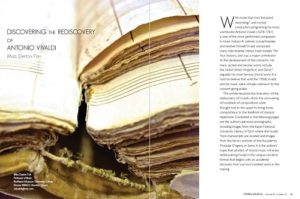The May 2015 issue of Choral Journal featured a fascinating article on Antonio Vivaldi. Vivaldi is one of the most performed composers in music history, but until the 1950s, Vivaldi and his music were virtually unknown to the concert-going public.
The article “Discovering the Rediscovery of Antonio Vivaldi” by Miles Dayton Fish “recounts the true story of the uncovering of hundreds of compositions once thought lost to the quest to bring those compositions to the forefront of classical repertoire.” The author’s personal photographs from the Italian National University Library in Turin and the library archives of the Accademia Musicale Chigiana are included in the article.
Below is a Vivaldi article timeline, with main events starting in 1678 when Vivaldi was born to present day. In 1926, Turin monks discovered crates of Vivaldi manuscripts that had been thought to be lost after the composer’s death nearly two centuries earlier. However, the story did not end there. The collection was found to be incomplete, and a search began to find the remainder of the Vivaldi manuscripts. This article is unique in that is reads almost like fiction; it would be especially interesting for those who teach choral history.
Click here to read the full article online or download the PDF of the Vivaldi article. (Note: You must be logged into the acda.org site as a member in order to access the Choral Journal online.)
Are you aware of the unique history of Antonio Vivaldi’s manuscripts? Do you know of any other interesting stories in the choral music timeline?
Vivaldi Article Timeline
1678 – Vivaldi born
1716 – Vivaldi meets violinist Johann Georg Pisendel in Venice
1717 – Pisendel returns to Dresden with 40 Vivaldi instrumental works
1741 – Vivaldi dies and his personal manuscripts are sold to Venetian collector Jacopo Soranzo
1755 –Pisendel dies and his library is stored in a large cabinet at Dresden’s Catholic Hofkirche
1761 – Jacopo Soranzo dies and his collection of Vivaldi manuscripts is divided
Late 1700s – Matteo Luigi Canonici reassembles the Vivaldi manuscripts and sells the collection to Count Giacomo Durazzo
1794 – Count Durazzo dies, and the Vivaldi manuscripts are moved from Venice to the Durazzo villa in Genoa
1860 – Pisendel’s Vivaldi orchestral manuscripts are discovered in Dresden and moved to the SLBU Dresden
1893 – The Durazzo collection is divided between two Durazzo brothers
1922 – Marcello Durazzo dies and leaves his collection to the Turin Monastery
1926 – Monks at the Turin Monastery send Vivaldi manuscripts to Professor Alberto Gentili
1927 – Roberto Foa purchases and donates Vivaldi Turin manuscripts to the Turin Library in memory of his deceased infant son, Mauro.
1927 – The second half of the Durazzo Vivaldi manuscripts are discovered in the possession of Giuseppe Maria Durazzo
1930 – Giuseppe Maria gives permission to sell his manuscripts to the Turin Library
1930 – Filippo Giordano purchases Durazzo manuscripts and donates the collection to the Turin Library
October 30, 1930 – The Vivaldi collection is complete
1933 – Olga Rudge begins working for Count Guido Chigi at the Accademia Musicale Chigiana
1935-1936 – Olga Rudge travels to Turin to examine and catalogue the Vivaldi manuscripts
1938 – The Durazzo stipulation of “no practice/no performance” is lifted
1938 – Ezra Pound transcribes microfilms of the Vivaldi manuscripts from the Dresden library and performs them in Rapallo
1938 – Olga Rudge opens Centro Studi Vivaldiani
September 16-21, 1939 – Vivaldi Festival Week in Siena
September 27, 1939 – Warsaw surrenders to Germany and WWII begins
June 1940 – The Turin Library is damaged in air raids
December 1942-April 1943 – Historical documents and music manuscripts are moved from the Turin Library to the Castle of Montiglio d’Asti
1945 – Manuscripts at the Castle of Montiglio d’Asti are returned to the Turin Library
1945 – Dresden is bombed and Vivaldi manuscripts are damaged
1947 – Italian Antonio Vivaldi Institute is founded in Venice by Antonio Fanna
December 31, 1947 – Louis Kaufman debuts a portion of Vivaldi’s Four Seasons at Carnegie Hall
1951 – Kaufman launches a series of all-Vivaldi concerts
2015 – Vivaldi continues to be one of the most performed and recorded composers in history



James John says
Dear Amanda,
I was happy to see your post this morning about this excellent and informative Vivaldi article. When the article first came out, I had meant to write CJ: it unfortunately includes a significant error regarding the American premiere of Vivaldi’s Gloria. The article states that the American premiere took place in 1957 at Brooklyn College’s first Festival of Baroque Music. Actually, the first American performance was given by John Castellini and the Queens College Choral Society in May 1949. Castellini was a faculty member in the Music Department at Queens College-City University of New York, and founded the QC Choral Society in 1941. I am the current Music Director of the QC Choral Society, and the American premiere of the Gloria is an important fact in the group’s history, documented in the School of Music’s archives. I wish I knew more about how Castellini obtained the score; I believe he was doing research in Italy, and brought back an edition to the United States before it was commercially available here. In any case, I thought it would be valuable to mention this important correction to the timeline.
Amanda Bumgarner says
Thank you for the correction. I am glad to hear you enjoyed the article.